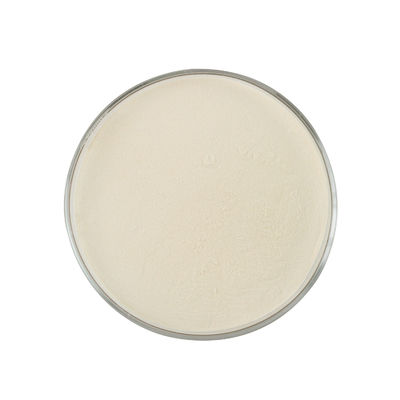Habio Cellulase Powder / Liquid/ Watersoluble Powder High Efficiency For Food Fermentation
Product Overview
Cellulose is a high molecular polysaccharide composed of glucose by β-1,4-glycosidic bonds. The degradation system of cellulase includes three main components: endoglucanase (EG), cellobiohydrolase (CBH), and β-glucosidase (βG). Endoglucanase acts on the surface of insoluble cellulose, destroying its crystal structure and exposing the inner cellulose chain to make it easy to be hydrolyzed. Cellobiohydrolase hydrolyzes the exposed cellulose chain into 2 or 4 units of oligosaccharides. Eventually, oligosaccharides are degraded into glucose monosaccharides by β-glucosidase. Cellulose can be completely degraded into glucose by the synergistic action of the above enzyme system.
With advanced microbial fermentation technology and post-processing technology, Habio cellulase can effectively degrade cellulose into oligosaccharides, improve the utilization rate of feed, increase the usage amount of unconventional raw materials, and reduce costs. Its main product features include: a) compared with other cellulases, it has better enzymatic hydrolysis efficiency, and owns a more reasonable distribution of enzyme system. b) advanced submerged fermentation production technology, and unique post-processing technology ensure the high enzyme activity and stability of Habio cellulase.
Product Functions
1. Application of cellulase in soy sauce brewing.
The brewing of soy sauce requires strong protease activity, and plant cleavage enzyme activity (Pectinase, hemicellulase and cellulase, etc.) is needed in order to fully expose soybean protease from tissue. When cellulase preparation is used in the production of solid salt-free soy sauce, it strengthens the rupture of the tissue structure of raw materials, makes the protein naked, facilitates the decomposition of protein by protease, increases the yield of soy sauce, accelerates the fermentation speed, increases the reducing sugar and chromaticity in soy sauce, improves the flavor and quality of soy sauce, shortens the production cycle, and the effect is obvious.
2. The role of cellulase in vinegar brewing.
In the process of vinegar brewing, the mixed use of cellulase and Glucoamylase can obviously improve the utilization rate of raw materials and the rate of production. When cellulase was used in liquid fermentation to brew vinegar, the alcohol yield, vinegar yield and yield of main materials were significantly improved.
3. Application of cellulase in ethanol production.
Cellulose continuously produces glucose under the action of cellulase and alcohol for the action of yeast. The addition of cellulase in alcohol fermentation can significantly increase the liquor yield and the utilization rate of raw materials, reduce the viscosity of mash and shorten the fermentation time.
4. Application of cellulase in beer production.
In the process of beer production, after the use of cellulase, starch and cellulose can be converted into sugar at the same time, and then decomposed by yeast, all of them can be converted into alcohol, thus improving the liquor yield and the utilization rate of starch and fiber. In the germination production of beer industry, it can increase the solubility of wheat grains, accelerate germination, reduce the content of β-glucose in saccharification solution, and improve filtration performance. The use of cellulase to hydrolyze brewer's grains and the effective utilization of enzymatic hydrolysate and residue can greatly improve the economic and environmental benefits of brewer's grains.
5. Application of cellulase in monosodium glutamate production.
Cellulase was added into the production of monosodium glutamate from wheat starch to improve the yield of pure protein from wheat gluten. In addition, due to the role of cellulase, starch liquefaction is generally easy to reflect and protein flocculation is better, the filtration speed of sugar water is improved, and the light transmittance of the sugar solution is improved. The use of cellulase in wheat starch production of monosodium glutamate can increase the yield of monosodium glutamate and shorten the production time.
Definition of Activity
One Cellulase Unit (U/g or U/mL) is defined as the amount of enzyme required to release 1 μmol of reducing sugar from a sodium carboxymethyl cellulose solution with a concentration of 5 mg/mL per minute at 50℃ and pH 4.8. (Reducing sugar is equal to glucose.)
Product Characteristics
-
High enzymatic efficiency at 30-70℃;
-
Wide pH range, strong pH tolerance and temperature tolerance;
-
The optimized genetic engineering strain, advanced liquid submerged fermentation technology and unique post-processing technology ensure the high activity and stability of Habio cellulase;
-
More reasonable distribution of enzyme system, better characteristics and stronger enzymolysis efficiency than other cellulases.
Specification & Application
|
Trade Name
|
Type
|
Activity
|
Application
|
|
Habio Cellulase
|
Powder;
Liquid;
Watersoluble powder
|
20,000 U/g~40,000 U/g;
20,000 U/g;
20,000 U/g~40,000 U/g
|
The practical usage should be determined in test based on using condition. Please contact Habio technicians for specific application schemes.
|
Package & Storage

Store solid enzyme for 12 months and liquid enzyme for 6 months in original and sealed package below 25℃.
Avoid to be exposed to the sun, rain, high temperature and high humidity.
Certifications

Contact Us
Julie Liu
Mianyang Habio Bioengineering Co., Ltd.
An ISO9001-2015, ISO22000, FSSC22000, FAMI-QS, FDA, HALAL and Kosher Certified Company
Mob/WhatsApp/WeChat: +86 18482001644 Tel: +86 28 85573389
Add: No.69 Hongen East Road, Economic-Technological Development Area, Mianyang, Sichuan, China
Web: www.habio.net


![]()
![]()